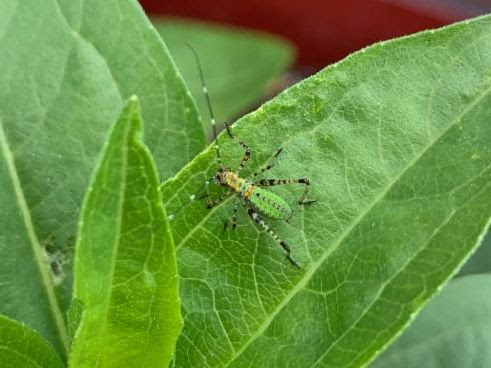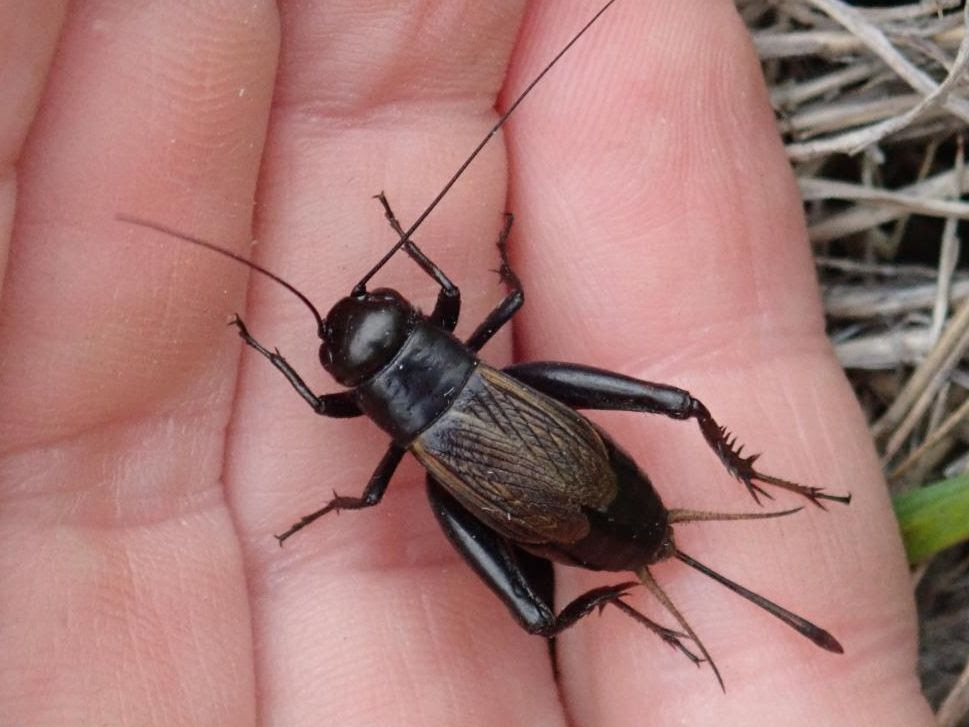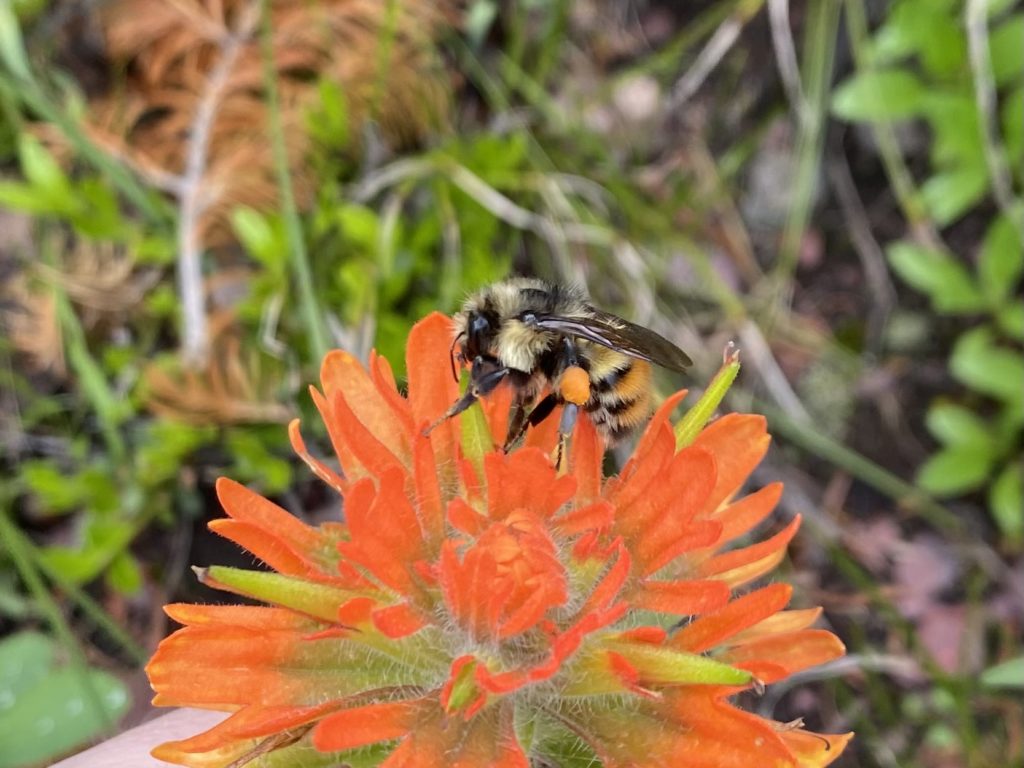Happy official start to the summer! Though it certainly hasn’t felt like it the last few days (in Missoula, at least), we’re approaching the warmest and buggiest time of the year. It may have been chillier than usual recently, but insect diversity is high, with 7 orders represented in this week’s dispatch. Stay buggy out there!

Bush Katydid Nymph
Scudderia sp.
While difficult to identify to species, this striking katydid is easily recognized as a Scudderia nymph thanks to its banded antennae. Katydids in this genus range throughout the United States and into southern Canada. The adults feed on broad-leaved woody deciduous plants while the nymphs can be found perusing a variety of herbaceous flowers. Adults may be found from early summer into autumn, often dying off around the first hard freeze; meanwhile, their eggs will survive the winter, falling to the ground in the autumn with the leaves they are attached to.
Nicole Schulz, June 15th, 2023. Missoula, MT.
Western Tent Caterpillar
Malacosoma californica
As you can see, unlike many caterpillars that venture out on their own to feed, these guys like company and spend a large part of their life congregating in a silken tent. On years where their population is high, the caterpillars can completely defoliate their host tree. When the caterpillars reach their later stages of development, they will break up the group, heading off individually to continue feeding and eventually pupate. In Montana, the adult moths are usually found from mid to late summer.
Brenna Shea, June 17th, 2023. Two Medicine, Glacier National Park, MT.


Bee Mimic Beetle
Trichiotinus assimilis
These fuzzy flower scarabs are easily recognized for their striking whitish-yellow striped pattern; though no one would blame you for mistaking them for a bumblebee. When in flight, these beetles are loud, and combined with their other bee-like characteristics, it may be hard to tell the difference until they land and offer a closer look. Beetles in this genus may be difficult to tell apart, but their range provides clues, with T. assimilis occuring across southern Canada and into the Rocky Mountain west.
Kelly Dix, June 16th, 2023. Blodgett Canyon, Hamilton, MT.
Northern Checkerspot
Chlosyne palla
Checkerspots are generally medium-sized, larger than crescents, and have orange and black checkered uppersides. Their flight is fairly fast, direct and low. They are on the wing in our area from mid June to mid July in a wide variety of habitats, from woodland openings to sagebrush. The males are territorial perchers, often seen in paths or on rocks, and both sexes may be seen feeding on flower nectar, mud, dung, and ash.
Kelly Dix, June 16th, 2023. Blodgett Canyon, Hamilton, MT.


Pond Spreadwing
Lestes sp.
Like many damselflies, identification to species is difficult, and especially so for this individual given that he may have recently emerged from his nymphal state. We can at least tell he’s a male, based on the “claspers” located at the end on the abdomen. During mating, the male will clasp the female behind her head so the pair remain connected even in flight. If the female is receptive, she will lift her abdomen to connect with the male’s accessory genitalia, located just behind his thorax, and the pair wind up in a shape not dissimilar to a heart.
Brenna Shea, June 19th, 2023. Rock Creek Confluence, Clinton, MT.
Marsh Fly
Helophilus sp.
These bee-like hoverflies are easy to distinguish from other bee mimics by their lengthwise-striped thorax and horizontal striped abdomen. We suspect this individual is Helophilus fasciatus, the narrow-headed marsh fly, though its range overlaps with a similiar species, the broad-headed marsh fly, and differentiating the two usually requires close inspection. The genus name, Helophilus, has Greek origins meaning “marsh lover.”
Kelly Dix, June 16th, 2023. Blodgett Canyon, Hamilton, MT.


Western Tiger Swallowtail
Papilio rutulus
All insect populations go through boom and bust cycles, and swallowtails certainly seem to be in the middle of a boom. These large, unmistakable butterflies seem to be everywhere these days. Males will often congregate in large puddling parties near stream banks or puddles to extract minerals and water from the damp earth. We only see one flight period in this part of their range, and by fall the new generation of caterpillars will pupate and overwinter in their chrysalid.
Brenna Shea, June 16th, 2023. MPG Ranch, Florence, MT.
Leafy Spurge Hawkmoth
Hyles euphorbiae
These large hawkmoths (sphinx moths) are a non-native species that were released in the fight against leafy spurge (the food source for their beautiful caterpillars, shown here). As the first biological agent to combat leafy spurge, these moths have inhabited the United States since 1965. The caterpillars are striking, with colors ranging from vivid green and yellow to dark red, orange and grey, depending on the caterpillar’s age. As adult moths, their wingspan can reach close to 10 cm, and like many day-flying moths, are often mistaken for hummingbirds.
Brenna Shea, June 19th, 2023. MPG Ranch, Florence, MT.


Spring Field Cricket
Gryllus veletis
Spring field crickets are the most common black cricket with a slowish chirp in the spring in many regions—ranging roughly through the northern half of the US. After overwintering as nymphs, we are now seeing adults with wings, and females sporting long, needle-like ovipositors (tube-like organ used to lay eggs). Most true crickets, which are characterized by flattened bodies with long, thin antennae, are omnivores that scavenge for dead bits of plants and animals.
Brenna Shea, June 19th, 2023. MPG Ranch, Florence, MT.
Large Yellow Underwing
Noctua pronuba
This large yet inconspicuous moth is another recently introduced species (the other being the leafy spurge hawkmoth mentioned earlier) that was introduced in Nova Scotia in 1979 and has since spread across the United States, arriving in the west in the early 2000’s. The name is a reference to the bold yellow hindwings, which remain hidden at rest but are revealed suddenly when the moth takes flight. Referred to as “bland-on-land and bright-in-flight,” the sudden flash of color is thought to confuse or startle predators.
Beverly Thomas, June 16th, 2023. Missoula, MT.


Cuckoo Wasp
Family Chrysididae
Like their namesake, the cuckoo bird, these tiny, bejeweled wasps lay their eggs in the nest of their host species and let other wasp parents do their work for them. Their larvae will consume the provisions provided by their host; and then consume the host offspring as well. Their diminutive size means they often go unnoticed, but with over 3,000 described species worldwide (and over 80 genera), these wasps comprise a huge family within the Hymenopteran order.
Heather McKee, June 16th, 2023. Missoula, MT.
Yellow-Fronted Bumblebee
Bombus flavirons
This robust, slightly disheveled-looking bumblebee is widely distributed across the western United States, usually occurring at high elevations. When the queen emerges in early spring, she will often make use of a disused mouse nest to start her colony. This species is often subject to parasitism by the indiscriminate cuckoo bumblebee (Bombus insularis), a parasitic bumblebee species featured in What’s Buzzin’ earlier this year.
Brenna Shea, June 17th, 2023. Two Medicine, Glacier National Park, MT.

Header photo: Ornate Checkered Beetle (Trichodes ornatus). Brenna Shea, June 17th, 2023. Two Medicine, Glacier National Park, MT.